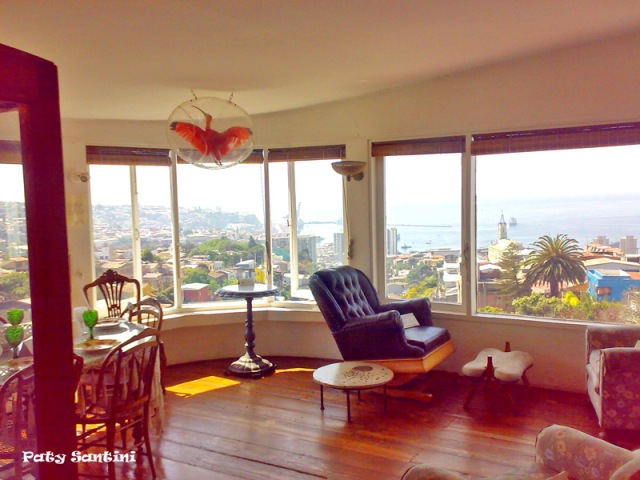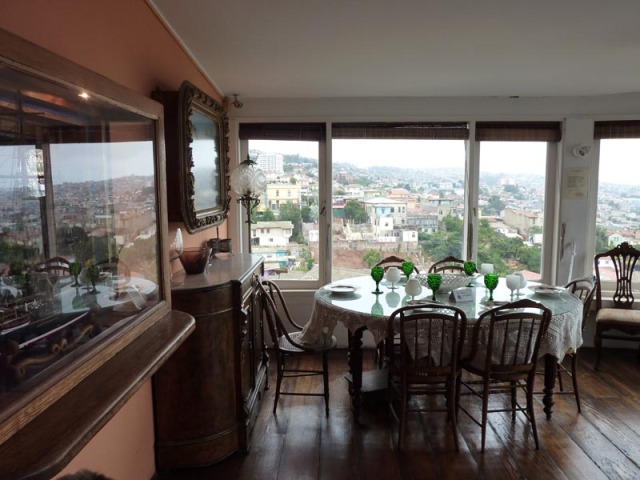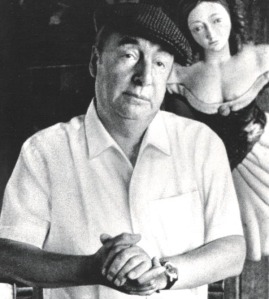He was born in Parral, a city in the south of Chile, with the name Ricardo Eliecer Neftalí Reyes Basoalto, later known throughout the world as Pablo Neruda.
Neruda enters to the Men’s Lyceum of Temuco in 1910, where he completed the high school.
In July 18, 1917, appears in the newspaper “The Morning” of Temuco, with the signing of Neftali Reyes, an article entitled “Enthusiasm and perseverance.” This is the first publication of the poet.
When he concludes his studies in the Lyceum, he went to Santiago to follow the career of Frenchman’s teacher in the Pedagogic Institute, but it continues preparing books of verses. In 1923 his first book of poems is edited, Crepusculario.
Since this moment, Neruda writes with more determination. In1924 publish a new book, by the title “Twenty poems of love and a desperate song”.
In 1971, Pablo Neruda obtained the Nobel Prize on Literature.
On the top of the reputation and of the recognition also they were waiting for it terrible hours. In 1973, September 11, it was surprised by the military intromission against the President Salvador Allende. Deeply affected by the new situation, it could not resist the tragedy and, on September 23rd he died in Santiago.
La Sebastiana: Museum House in Valparaiso
(From:“La Sebastiana” stiory, Pablo Neruda Fundation) “I feel the tiredness of Santiago. I want to find in Valparaiso a little house to live and write quietly. It must have some conditions. It can’t be located to high or to low. It should be solitary but not in excess. With neighbours hopefully invisibles. They shouldn’t be seen or heard. Original, but not uncomfortable. With many wings, but strong. Neither too big or too small. Far from everything but close to the transportation. Independent, but close to the commerce. Besides it has to be very cheap. Do you think I would find a house like that in Valparaiso?

This was the request Pablo Neruda asked in 1959 to his friends Sara Vial and Marie Martner. It seems impossible to find a house that satisfied the wishes of the poet, but after a long survey, they found the main frame of a mansion located on the Florida Hill. It was built by the spaniard Sebastian Collao, who assigned the whole third floor of the building as a bird cage. Don Sebastian died in 1949 and the unfinished house full of stairs was abandoned then for many years.

The poet went to see the building. He liked, among other things, the silly way it was constructed, but he found it too big, so the house was bought between Neruda and the sculptor Marie Martner and her husband, Dr. Francisco Velasco.
Today this house is the “La Sebastiana” Museum, located in the Florida Hill of Valparaiso and opened to public. You must knowing and crossing his collections and the stories that he guards.
Ode to Valparaiso
Pablo Neruda
What nonsense
You are
What a crazy
Insane Port.
Your mounded head
Disheveled
You never finish combing your hair
Life has always surprised you
Death woke you
In your undershirt and long underwear
Fringed with color
Naked
With a name tattooed on the stomach
And with a cap
The earthquake grabbed you
You ran
Mad
Broke your fingernails
It moved
The waters and the stones
Sidewalks
And seas
The night,
You would sleep
In the ground
Tired
From your sailing
And the furious earth
Lifted its waves
More stormy
Than a tempest
The dust
Covered you
The eyes
The flames
Burned your shoes
The solid
Houses of bankers
Trembled
Like wounded whales
While above
The houses of the poor
Leapt
Into nothingness
Like captive birds
Testing their wings
Collapse
Quickly
Valparaiso,
Sailor,
You forget
the tears
and you return
to hanging your dwellings
to paint doors
green
Windows
Yellow,
Everything
You transform into a boat
Your are
The patched bow
Of a small
Courageous
Ship
The crowns nest
With foam
Your rope lines that sing
And the light of the ocean
That shakes the masts
And flags
In your indestructible swaying
Dark star
You are
From far away
In the height of the coast
Shining
And soon
You surrender
Your hidden fire
The rocking
Of your deaf alleys
The naturalness
Of your movement
The clarity
Of your seamanship
Here ends this ode
Valparaiso
So small
Like a cloth
Helpless
Hanging
Ragged in a Window
Swaying
In the Wind
of the ocean
Impregnated
With all the pain
Of your ground
Receiving
The dew
Of the sea, the kiss
Of the wild angry sea
That with all of its power
Beat the rocks
It could not
Knock you down
Because on your southern chest
Is tattooed
The struggle
The hope
The solidarity
And the joy
As anchors
Resisting
The waves of the earth.
Pablo Neruda y Valparaíso
Nació en 1904 en Parral con el nombre de Ricardo Eliecer Neftalí Reyes Basoalto. Residiendo en Temuco, ingresó en el Liceo de la ciudad en 1910, y cuando aún no había salido de esta institución, el 18 de julio de 1917, pudo leer emocionadamente en un periódico local, La Mañana, el primero de sus artículos publicados, que tituló “Entusiasmo y perseverancia”.
Su padre se oponía abiertamente a que siguiera esta vocación, de modo que cuando el 28 de noviembre de 1920 obtuvo el premio de la Fiesta de Primavera de Temuco, el joven poeta ya firmaba sus poemas con seudónimo. El nombre elegido, Neruda, lo había encontrado por azar en una revista y era de origen checo.
Cuando concluye sus estudios en el Liceo pasa a Santiago para seguir la carrera de profesor de francés en el Instituto Pedagógico, pero continúa preparando libros de versos. En 1923 se edita su primer libro de poemas, Crepusculario.
A partir de entonces Neruda se entregó, con más ahínco, a la confección de otro libro, que terminaría publicándose en 1924 con el título Veinte poemas de amor y una canción desesperada.
En 1971, Pablo Neruda se convirtió en el tercer escritor latinoamericano y en el segundo chileno que obtenía el Premio Nobel de Literatura.
En la cúspide de la fama y del reconocimiento también lo esperaban horas amargas. En 1973, el 11 de septiembre, fue sorprendido por el golpe militar contra el presidente Salvador Allende. Profundamente afectado por la nueva situación, no pudo resistir la tragedia y el 23 de septiembre murió en Santiago.
La Sebastiana: Casa Museo de Pablo Neruda en Valparaíso
(De: Historia de “La Sebastiana”, Fundación Pablo Neruda) “Siento el cansancio de Santiago. Quiero hallar en Valparaíso una casita para vivir y escribir tranquilo. Tiene que poseer algunas condiciones. No puede estar ni muy arriba ni muy abajo. Debe ser solitaria, pero no en exceso. Vecinos, ojala invisibles. No deben verse ni escucharse. Original, pero no incómoda. Muy alada, pero firme. Ni muy grande ni muy chica. Lejos de todo pero cerca de la movilización. Independiente, pero con comercio cerca. Además tiene que ser muy barata ¿Crees que podré encontrar una casa así en Valparaíso?” (Pablo Neruda).
Éste fue el encargo que Pablo Neruda les había hecho, en 1959, a sus amigas Sara Vial y Marie Martner. Parecía difícil encontrar una casa que satisficiera las aspiraciones del poeta, pero después de mucho buscar apareció la obra gruesa de un caserón, ubicado en el cerro Florida. La había construido el español Sebastián Collado, quien destinó todo el tercer piso a una pajarera. Don Sebastián murió en 1949 y aquella casa inconclusa y llena de escaleras quedó abandonada durante muchos años.
El poeta fue a ver la construcción. Le gustó, entre otras cosas, por lo disparatada que era, pero la encontró muy grande, de modo que la compró a medias con la escultora Marie Martner y a su marido, el doctor Francisco Velasco.
Hoy esa casa es el Museo la Sebastiana, ubicada en el Cerro Florida de Valparaíso y abierta a público. Vale la pena conocerla y recorrer sus colecciones y la historia que guarda.
Oda a Valparaíso
Pablo Neruda
VALPARAÍSO,
qué disparate
eres,
qué loco,
puerto loco,
qué cabeza
con cerros,
desgreñada,
no acabas
de peinarte,
nunca
tuviste
tiempo de vestirte,
siempre
te sorprendió
la vida,
te despertó la muerte,
en camisa,
en largos calzoncillos
con flecos de colores,
desnudo
con un nombre
tatuado en la barriga,
y con sombrero,
te agarró el terremoto,
corriste
enloquecido,
te quebraste las uñas,
se movieron
las aguas y las piedras,
las veredas,
el mar,
la noche,
tú dormías
en tierra,
cansado
de tus navegaciones,
y la tierra,
furiosa,
levantó su oleaje
más tempestuoso
que el vendaval marino,
el polvo
te cubría
los ojos,
las llamas
quemaban tus zapatos,
las sólidas
casas de los banqueros
trepidaban
como heridas ballenas,
mientras arriba
las casas de los pobres
saltaban
al vacio
como aves
prisioneras
que probando las alas
se desploman.
Pronto,
Valparaíso,
marinero,
te olvidas
de las lágrimas,
vuelves
a colgar tus moradas,
a pintar puertas
verdes,
ventanas
amarillas,
todo
lo transformas en nave,
eres
la remendada proa
de un pequeño,
valeroso
navío.
La tempestad corona
con espuma
tus cordeles que cantan
y la luz del océano
hace temblar camisas
y banderas
en tu vacilación indestructible.
Estrella
oscura
eres
de lejos,
en la altura de la costa
resplandeces
y pronto
entregas
tu escondido fuego,
el vaivén
de tus sordos callejones,
el desenfado
de tu movimiento,
la claridad
de tu marinería.
Aquí termino, es esta
oda,
Valparaíso,
tan pequeña
como una camiseta
desvalida,
colgando
en tus ventanas harapientas
meciéndose
en el viento
del océano,
impregnándose
de todos
los dolores
de tu suelo,
recibiendo
el rocío
de los mares, el beso
del ancho mar colérico
que con toda su fuerza
golpeándose en tu piedra
no pudo
derribarte,
porque en tu pecho austral
están tatuadas
la lucha,
la esperanza,
la solidaridad
y la alegría
como anclas
que resisten
las olas de la tierra.










Pingback: Valparaíso « Silvia Viñas